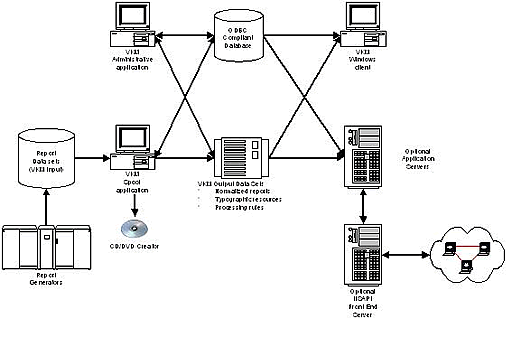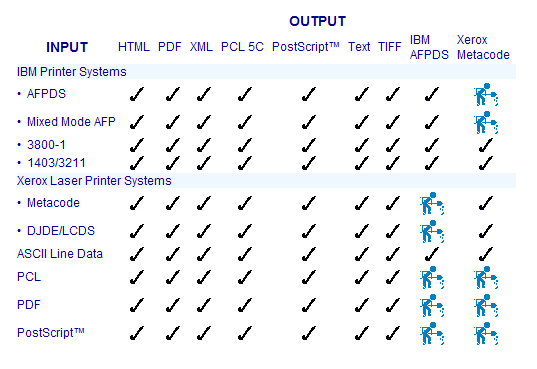
VKM Architecture
VKM components are displayed in the following diagram and described below:

VKM Administrative Application
The VKM administrative application defines report data sets, business processing rules and user security attributes. It is a Windows work-station application requiring Windows 98 or Windows NT SP 6.0 or higher.
VKM Spool Application
The VKM spool application processes input report data sets, converts them to their normalized format and stores the indexed data sets in de-fined output areas. It is a Windows workstation application requiring Windows 98 or Windows NT SP 6.0 or higher.
VKM CD/DVD Creator Application
The VKM CD/DVD creator application is a management interface into VKM that encapsulates reports into CD/DVD format.
VKM Windows Client
The VKM Windows client requests and renders document pages. It is a Windows Thick Client Application requiring Windows 98 or Windows NT SP 6.0 or higher.
Optional Application Servers
The VKM application servers process Web client requests to render document pages. They are DCOM servers and require Windows ME or Windows NT SP 6.0 or higher. The application servers can co-exist on the same front-end servers as IISAPI front-end servers.
Optional IISAPI Front-End Server
The IISAPI front-end server provides presentation capabilities for web clients. The Web clients must support HTML 4.0 standards and the Microsoft Document Object Model.
Developer APIs
Our 32-bit conversion APIs enable you to process and view the following print data streams:
- IBM's Advanced Function Presentation Data Stream (AFP/AFPDS)
- IBM Line Data (1403/3211 and ISDN PageDef/FormDef)
- Xerox Metacode
- Xerox DJDE Conditioned Line data
- PDF input
- PCL input
- PostScript input
In addition, our Rendering API is used in conjunction with transform components to provide on-demand conversion and viewing of AFP, Metacode, and line data pages.
The Data Stream Formats table below shows supported transforms available:

Highlights
- Supports conversion and rendering of input data print streams
- Common API supported for all data print stream formats
- Supports output to:
- HTML
- PCL
- PNG
- PostScript
- TIFF
- Raster Bitmaps
- Search and Display
- On-the-fly conversion and rendering, and the ability to cache transformed resources for enhanced performance
- Fully re-entrant code, allowing concurrent conversion of multiple pages and resources
Rendering API
Our Rendering API is common to all of our conversion APIs. The Rendering API takes your converted data from our internal format and renders those pages using 32-bit Graphical Device Interface (GDI) calls compatible with Windows 9x, 2000, NT, and XP.
The Rendering component works concurrently with the transform components to provide on-demand conversion and viewing of IBM AFPDS, Xerox Metacode, Line Data, and PDF pages.
Highlights
- Rotates a converted page through matrix multiplication and then render that page in its new orientation, a method that is faster and less memory intensive than rotating bitmaps and works with both printer and memory device contexts.
- Scales a graphically distinct page, allowing the calling application to zoom in or out and to print on devices with resolutions and margins different from the original printer
- Outputs to graphical channels including HTML, PDF, PCL, and Postscript
Viewing and Printing Channels
The Rendering API supports the following viewing and printing channels:
HTML
- Quickly renders intelligent print data streams for distribution over Internet and/or Intranet channels
- Allows you to create viewable pages for any browser supporting positioned text
- Provides thin client and browser support across slow Internets or Intranets, reducing delivery time and bandwidth constraints
- VAP renders legacy data streams for viewing via Adobe Acrobat Reader
- Administrators can index information and provide a table of contents for statement runs
- Allows viewers to view the entire contents of a print stream or a designated portion of it
Windows GDI
- Makes a call to a GDI function and sends it the object needed for appropriate display or printing
- GDI will then "draw" the object by sending commands to the screen and printer drivers, which render the images
- GDI contains the rendering technology for outputting device dependent bitmaps (BMP), device independent bitmaps (DIB) and for printing to Windows supported printers
Search & Display
- Allows you to search for specified text within the Row Columnized pages and then retrieve and display that text for review
- Rendering technology is capable of building information needed for hit testing, data mining and text searching
PCL
- Page description language for HP LaserJet printers, used by many printers and typesetters
- PCL Level 6 streamlines the graphics and font commands, reducing the amount of information that has to be sent to the printer.
PostScript
- Page description language designed by Adobe and used on all platforms
De facto standard for commercial typesetting and printing - PostScript commands are language statements in ASCII text that are translated into the printer's machine language by a Postscript interpreter built into the printer
- Fonts are scaled to size by the interpreter, eliminating the need to store a variety of font sizes on disk.
Why Use Our APIs
Our APIs can be used for:
- Extraction of information from formatted print data streams
- Transformation of print data streams for viewing or reprinting
- Archiving and indexing of information for reprinting or viewing at a later date
